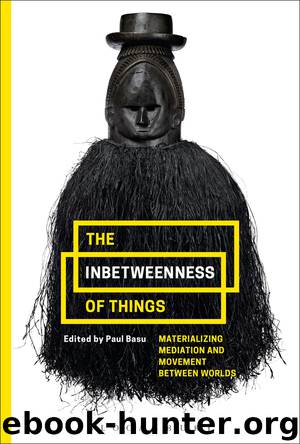The Inbetweenness of Things by Paul Basu

Author:Paul Basu
Language: eng
Format: epub
Publisher: Bloomsbury UK
Published: 2017-03-02T16:00:00+00:00
FIGURE 8.3A number of highly polished black stone Inca conopa, five of which are alpacas with stylized folds of fleece carved around their necks. Museo Inka, Universidad de San Antonio Abad del Cuzco. Photograph by Bill Sillar.
I have reviewed collections of carved stone conopa held in various museums, including Museo Inka, Cuzco; Museo de Antropologia y Arqueologia, Lima; the Field Museum, Chicago; the British Museum, London; the Pitt Rivers Museum, Oxford; and the Museum of Archaeology and Anthropology, Cambridge. Many examples in these collections are in the shape of llamas or alpacas, ranging in length from 5 to 15 cm, and carved from a wide range of stone types, some of which have distinctive coloration and banding. A small number of the llama and alpaca conopa in the Museo Inka have come from secure Inca contexts in the Cuzco region, particularly from excavations in the area of Sacsayhuman, so we know that some of these objects were being produced by the Inca. The choice of stone, the size and shape of the animal, and the quality of carving is variable, suggesting that many are ‘one-offs’ carved out of ‘charming’ stones found by non-specialists. But there are also recognizable groups made in similar forms using consistent raw materials. For instance, some highly polished fine black and dark green serpentine stone, alpacas with stylized folds representing the wool around their neck and a hollow in their back, are particularly distinctive, with examples of these in each of the above collections (Figure 8.3). A preliminary look at the elemental composition of some of these, as measured by portable X-ray fluorescence, suggests there are two distinct compositional groups representing two sources for a large number of the carved stone conopa. This points to fairly large-scale production, which is quite different from the rather individual relationship to ‘found objects’ described by most colonial sources. In the absence of a market trade within the central part of the Inca Empire, the large-scale production and distribution of these conopa suggests institutional involvement in their production and circulation. The large-scale production of these black conopa in the non-market Inca economy, and the large number of these found in and around the Inca capital of Cuzco, indicates that the state is likely to have been involved in distributing them. An association with state rituals and prestigious huaca would have added to the power of these conopa, and their use as gifts to trusted devotes and state workers could have been a powerful tool of apparent state largess that brought the state into the core of household identity, with the conopa taking Inca state institutions into the intimacy of family/household concerns.
Download
This site does not store any files on its server. We only index and link to content provided by other sites. Please contact the content providers to delete copyright contents if any and email us, we'll remove relevant links or contents immediately.
| Africa | Americas |
| Arctic & Antarctica | Asia |
| Australia & Oceania | Europe |
| Middle East | Russia |
| United States | World |
| Ancient Civilizations | Military |
| Historical Study & Educational Resources |
Underground: A Human History of the Worlds Beneath Our Feet by Will Hunt(11256)
Navigation and Map Reading by K Andrew(4553)
Sapiens by Yuval Noah Harari(4537)
Barron's AP Biology by Goldberg M.S. Deborah T(3631)
The Sympathizer by Viet Thanh Nguyen(3479)
5 Steps to a 5 AP U.S. History, 2010-2011 Edition (5 Steps to a 5 on the Advanced Placement Examinations Series) by Armstrong Stephen(3406)
Three Women by Lisa Taddeo(2920)
The Comedians: Drunks, Thieves, Scoundrels, and the History of American Comedy by Nesteroff Kliph(2790)
Water by Ian Miller(2582)
Drugs Unlimited by Mike Power(2192)
DarkMarket by Misha Glenny(1846)
The House of Government by Slezkine Yuri(1844)
The Library Book by Susan Orlean(1737)
A Short History of Drunkenness by Forsyth Mark(1719)
Revived (Cat Patrick) by Cat Patrick(1678)
The Woman Who Smashed Codes by Jason Fagone(1649)
The House of Rothschild: Money's Prophets, 1798-1848 by Niall Ferguson(1618)
And the Band Played On by Randy Shilts(1615)
Birth by Tina Cassidy(1572)
